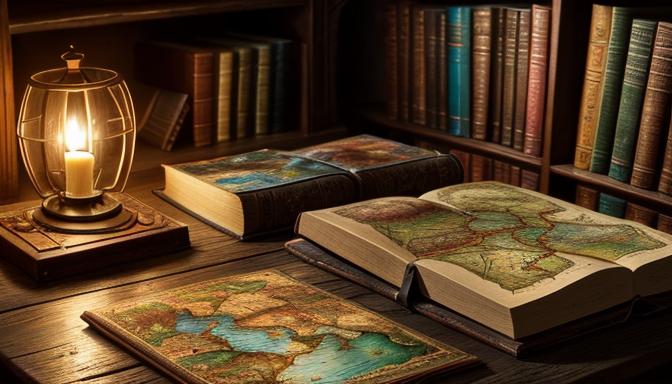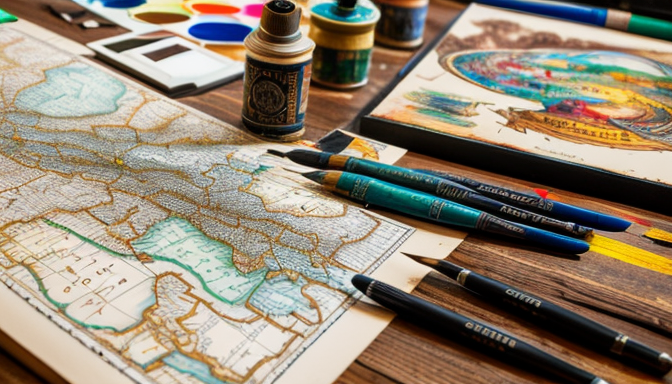Imagine diving into a novel and being greeted not just by words, but by intricate maps that guide your journey through fantastical realms. The intersection of art and maps in fiction is like a vibrant tapestry, weaving together narrative and visual storytelling. These maps are not merely decorative; they serve as dynamic tools that enhance the reader’s experience, allowing them to visualize the landforms, kingdom borders, and the vastness of the realms being explored.
When authors collaborate with talented cartographers, the result is a stunning blend of creativity and precision. Think about it: a well-designed fantasy map can make you feel as though you are walking through enchanted forests or scaling the peaks of towering mountains. This immersive worldbuilding invites readers to engage with the story on a deeper level, as they can trace the paths of their favorite characters and envision the landscapes that shape their adventures.
Furthermore, these artistic interpretations often reflect the underlying themes of the narrative. For instance, a map that highlights treacherous terrains might symbolize the challenges the protagonist faces, while lush, vibrant areas could represent hope and prosperity. By analyzing these elements, readers can uncover hidden meanings and appreciate the author’s artistic vision.
Visual Storytelling Through Cartography
When you dive into a fictional world, what pulls you in deeper than the characters and plot? It’s often the maps that guide your imagination, right? Maps in fiction are not just simple diagrams; they are intricate blueprints of entire realms, carefully crafted to enhance the storytelling experience. Think about it: a well-designed fantasy map can transport you to lands filled with mystical creatures, towering mountains, and sprawling kingdoms. Each landform, from jagged peaks to serene valleys, tells a story of its own.
As readers, we crave that sense of place. When a map illustrates the journey of a hero, it allows us to visualize their trials and triumphs. Imagine following a character’s path through a treacherous forest or across a vast desert. The visual representation of their journey adds layers of depth to the narrative. It’s like being handed a treasure map, where X marks the spot of not just a location, but also pivotal moments in the story.
Moreover, the design of these maps often reflects the cultural and political landscapes of the fictional world. Kingdom borders, for instance, can signify conflicts, alliances, and histories that shape the narrative. A table below illustrates how different elements of cartography can enhance worldbuilding:
| Element | Significance |
|---|---|
| Landforms | Influence character movement and plot development |
| Kingdom Borders | Represent political tensions and alliances |
| Legends | Provide context and history, enriching the narrative |
In essence, maps serve as a visual narrative that complements the written word, allowing readers to not just follow along but to truly immerse themselves in the world. So, the next time you pick up a fantasy novel, take a moment to study the map. It’s not just a tool; it’s a gateway into the heart of the story.

The Role of Artistic Interpretation
When it comes to fiction, artistic interpretation of maps plays a pivotal role in shaping the reader’s experience. Think of a map not just as a guide, but as a canvas that paints the essence of a world. The intricate details of fantasy maps, from the jagged edges of mountains to the winding rivers, are not merely decorative; they serve as a portal into the realms and kingdoms that authors have meticulously crafted.
Imagine flipping through the pages of a fantasy novel and landing on a beautifully illustrated map. Instantly, you’re transported to a place where every landform tells a story. The design of these maps can evoke emotions, hinting at the dangers of the shadowy forests or the allure of shimmering seas. For instance, a map that features sprawling kingdoms bordered by treacherous terrains can symbolize the struggles and triumphs of its inhabitants. This visual representation not only enhances the narrative but also invites readers to engage with the story on a deeper level.
Moreover, the artistic choices made in map design can reflect the themes of the narrative. A map with chaotic borders may suggest conflict, while a harmonious layout might indicate peace. As readers, we are drawn to these details, allowing our imagination to fill in the gaps. In this way, maps become more than just geographical tools; they transform into symbolic narratives that resonate with the story’s core message.
Frequently Asked Questions
- How do maps enhance storytelling in fiction?
Maps act as a visual anchor for readers, giving them a tangible sense of place and helping them visualize the journeys of characters. They can make a fictional world feel more immersive, almost like a character in itself!
- What is the significance of artistic interpretation in fictional maps?
Artistic interpretations can transform simple geographical outlines into emotional landscapes. They often reflect the themes and emotions of the story, turning a map into a symbolic narrative that resonates with readers on a deeper level.
- Can maps influence how we perceive characters and their journeys?
Absolutely! A well-crafted map can shape our understanding of a character’s journey and growth. It highlights the challenges they face and the transformations they undergo, making their story more relatable and impactful.

Recent Comments